Exhibits

Pipe (Wood/Ivory)
Iñupiat pipes are most commonly made of ivory or bone, however, the artifact on display is constructed of both wood and ivory. The bowl is crafted of ivory and the stem of wood suggesting that the pipe had been quickly repaired with a simple wooded pipe stem. Since European contact tobacco has played an important role in Iñupiat culture as parts of ritual and religious ceremonies. Tobacco was also grown and cultivated by the Iñupiat after its arrival in northern Alaska.
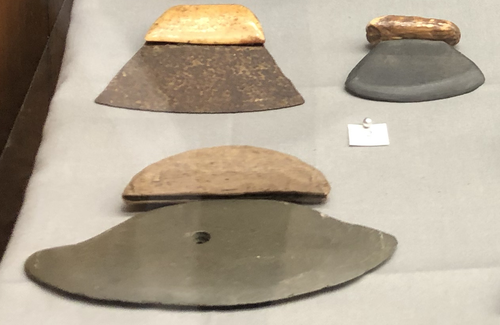
Ulus (Stone/Iron/Wood/Ivory)
Stone and iron Ulus alike were used for many purposes in the Iñupiat culture. Ulus are typically utilized and processing whale and seal meat harvested in seasonal hunting practices. These versatile tools are inherited from elder women in the Community and held as a powerful symbol of Iñupiat women's culture and history.
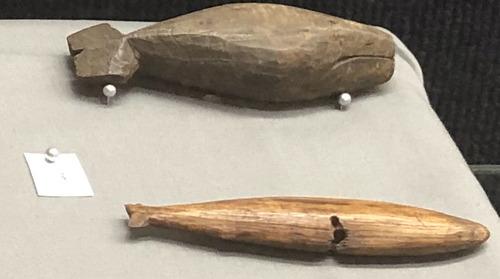
Humpback whale carving (Wood); 97 mm x 24 mm long
This artifact is an example of decorative artwork that appeared in Iñupiat tribes off the coast of Northern Alaska. This piece of artwork is carved into the shape of one of their most important sources, the humpback whale. The whale effigies have a myriad of speculated purposes. The interpretations claim that they could have been made specifically to sell to visiting parties or perhaps they were charms to be carried in the boat to secure good luck and wailing, or maybe simple toys for children.
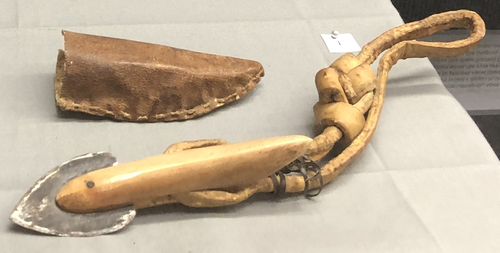
Knife and Sheath (Iron/Reindeer Antler)
There are various types of knives found in the Northern Alaska region. One of which is the crooked knife typically used for woodworking. The blade has a sharp point like those of large knives, projecting beyond the end of the half. This knife blade is attached to a reindeer antler handle with two iron rivets. Sheaths for Iñupiat knives were often made of seal skin with an opening at one end to store the blade.

Fishing Spears (Wood)
The artifacts on display are 10 fishing Spears of differing styles. Some long and singular, some short and jagged with additional prongs. Fishing is vital to the Iñupiat culture and is achieved in many ways. Some by harpoon, others by net, and more still by fishing spear. Often the Iñupiat people would use these fishing spears in partnership with what they call a fish weir – a stone wall built up to trap fish – so they could subsequently use the spears – attached to a larger shaft, in this case probably with a single spear attached at the head – to strike the trapped fish with deadly precision.

Fishing Hooks (Ivory, Copper, Iron)
Fishing with hook and line seems to have been a practice later adopted by the Iñupiat culture. The fish hooks found in the Northern Alaska region have copper and iron barbs indicating a European influence. These lures were most commonly made of bone or antler and carved into the shape of small fish or a teardrop-like shape.

Harpoon Heads (Stone, Ivory, Bone)
The artifacts displayed are four harpoon heads and are intricately decorated in a variety of styles, reflecting the weapons multitude of adaptations throughout the thousands of years harpoon has existed in Iñupiat culture. Traditionally, the materials necessary for the construction of these common hunting tools include wood, ivory or antler for the shaft as well as the head, and sometimes a detachable stone projectile point for the head.
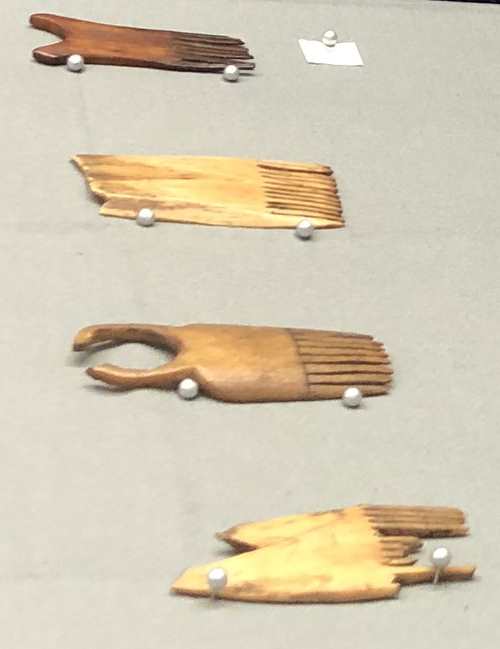
Bone Combs (Bone/Antler/Ivory)
Iñupiat hair combs are typically carved out of ivory and, more infrequently, antler or bone. They would have been used in domestic areas for combing hair and personal adornment. These Combs served as key symbols of personal expression and cultural remembrance within the Iñupiat culture.

Bone needles (Bone)
These bone needles are thicker than modern sewing needles because natives use them to sew animal skins. Specifically, they used Caribou sinews to sew the heavy animal skin together for clothing. This item on display is a well-preserved example and shows few markings or other signs of wear.
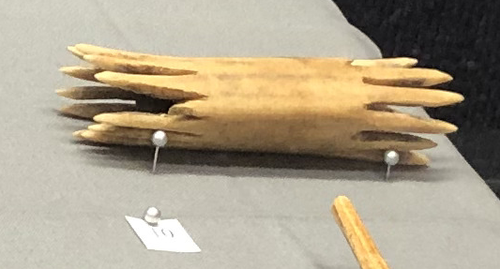
Modified Bone Comb (Bone)
Combs like these are usually made from materials like antler or bone. The center of the bone or antler piece would be hollowed out and the ends carved into a series of prongs. These combs would be used to process animal hides. Their easy-to-hold design and sharp prongs allowed them to easily shear off remaining animal hair so the skin could be used. It is also believed this comb would have been used for rooting bugs out of textiles to prevent them from spreading further period.
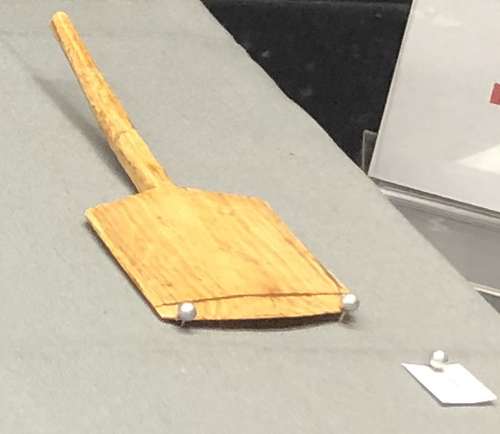
Bone Scraper (bone)
This bone scraper, was most likely used for processing hides that had been harvested from the animals such as seals, Caribou and reindeer. These hides would be processed by women, who appear to do most if not all of this work, using a tool consisting of a blunt blade, mounted in a short, thick haft of wood or ivory, fitting exactly to the inside of the hand and having holes, hollows, or grooves to receive the tips of the fingers and thumb.
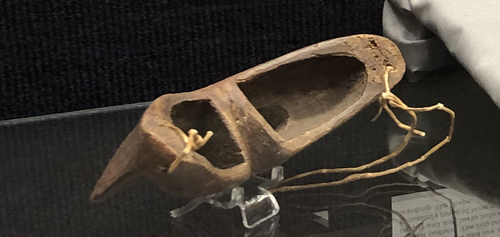
Snow Goggles (Wood)
These snow goggles are made of wood and come from Utkiagvik, Alaska, the northernmost point of the United States. They are called i'dylgŭŭ in the local Iñupiaq language. Goggles like these were used to prevent snow blindness during the winter months. Snow blindness occurs when the eyes are damaged by UV rays reflected off of ice and snow. Goggles like these limited the amount of light the eyes were exposed to, and enabled the Iñupiaq people to carry out daily activities. They have also been made out of bone, ivory, and bark.
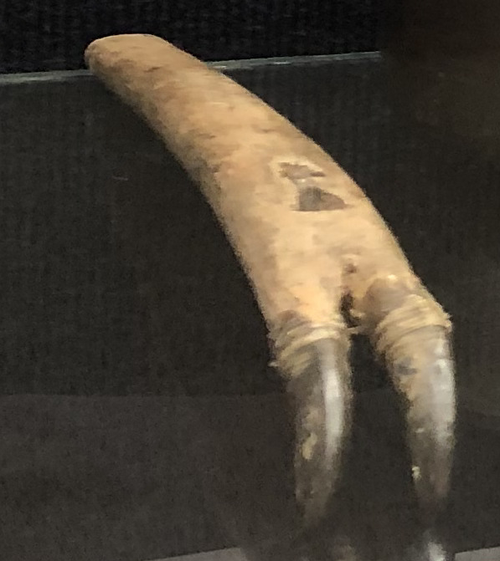
Ice scraper (Unknown animal, Sinew, and animal claws, Unspecified, 11 in. long)
Seal hunting tools were used by women to lure seals during hunting forays. The noise created by these activities would attract seals nearer to openings cut in the ice sheets. The general premise is that these tools mimic the noise made by prey or other seals. * Not numbered in exhibit
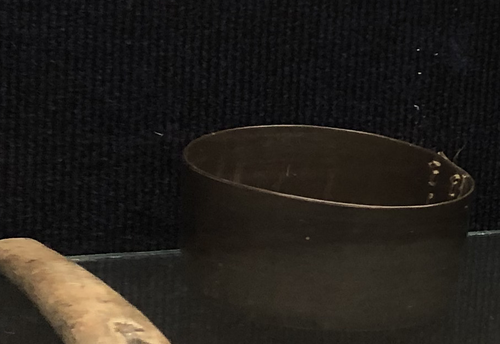
Bentwood Box (Wooden Container)
This artifact is an example of a very versatile object used cross-culturally amongst indigenous Arctic peoples such as the Iñupiat called “bentwood” boxes. These boxes are formed by steaming slim planks of wood and bending them over the knee, binding the ends together with twine, sinew or wooden “staples” like this one, then finally attached to a concave base. The one seen here is rather simple with many scuff marks on the inner base, likely indicating its regular, practical use as something resembling a food container.
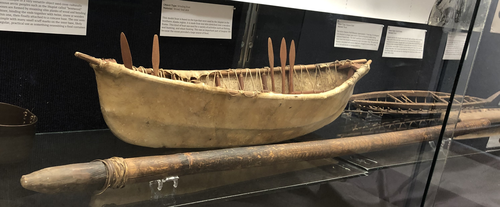
Whaling Boat, model (Wood/Seal Skin)
Harpoon Shaft (Wood)
This model boat is based on the type that were used by the Iñupiat in the Northern Alaska region. It is made from seal skin stretched over a wooden frame. This kind of boat was used for a variety of activities such as fishing, seal hunting, and whale hunting. This was an important part of Iñupiat life because the ocean provided a large source of food.
This hollow Harpoon Shaft measures approximately 2.5 feet long. It is designed to be attached to a longer spear which is thrown at humpback whales during traditional Iñupiat hunts. This shaft would have carried the harpoon head into the whale which would then be attached by a rope to the hunter’s boat. This particular harpoon is decorated with extreme detail and is thought to record symbols that convey luck and success on hunting expeditions.

Kayak frame, model (Wood)
Wood Fire-Starting Implement (Wood)
Kayaks used by the Iñupiat were typically light and sharp with a rounded bilge, part of the hull that would rest on the ground if the vessel were unsupported by water. Kayaks were used by those who remained near the villages in the summer chiefly for making these short excursions to the lakes and streams inland after reindeer and for making short trips from camp to camp along the coast. Kayaks also had uses during hunting as they were used in setting stake-nets and also for retrieving fowl which have fallen in the water when shot.
This fire-starting tool was found at Point Barrow and resembles other styles of fire tools that had been found there. A stick would be inserted into the top and then spun vigorously to create friction. This friction would create heat and sparks which would most likely be caught with a ball of tinder. The flames would be coaxed into a larger fire that would be used for cooking, warmth, light, etc.
